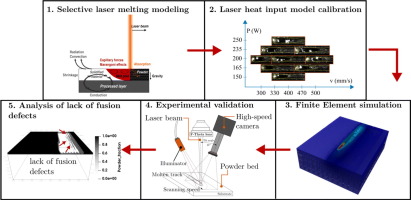当前位置:
X-MOL 学术
›
Mater. Des.
›
论文详情
Our official English website, www.x-mol.net, welcomes your feedback! (Note: you will need to create a separate account there.)
Selective Laser Melting Finite Element Modeling: Validation with High-Speed Imaging and Lack of Fusion Defects Prediction
Materials & Design ( IF 8.4 ) Pub Date : 2018-10-01 , DOI: 10.1016/j.matdes.2018.06.037 Claire Bruna-Rosso , Ali Gökhan Demir , Barbara Previtali
Materials & Design ( IF 8.4 ) Pub Date : 2018-10-01 , DOI: 10.1016/j.matdes.2018.06.037 Claire Bruna-Rosso , Ali Gökhan Demir , Barbara Previtali

|
Abstract Selective laser melting (SLM) is a fast-growing technology which still lacks knowledge and management for wider industrial use. Numerical modeling is today a standard tool in the manufacturing industry to support design and process parameters determination. It is thus of great importance to experimentally validate the simulations in order to ensure their predictive capabilities. However, the fast nature of the process complicates observation of the quantities required for the simulation validation. A finite element model (FEM) of the SLM process is proposed here, together with its numerical validation by comparison with the literature, and experimental validation using high-speed imaging. The melt pool widths and lengths retrieved from the simulation and the videos were measured. The model demonstrated a good accordance with both the literature and the experimental results. Reduced melt pool geometries were simulated in the first tracks which led to lack of fusion defect formations.
中文翻译:

选择性激光熔化有限元建模:高速成像验证和缺乏融合缺陷预测
摘要 选择性激光熔化(SLM)是一项快速发展的技术,但仍缺乏更广泛的工业应用的知识和管理。如今,数值建模已成为制造业中支持设计和工艺参数确定的标准工具。因此,通过实验验证模拟以确保其预测能力非常重要。然而,该过程的快速特性使模拟验证所需数量的观察变得复杂。这里提出了 SLM 过程的有限元模型 (FEM),连同其与文献相比的数值验证,以及使用高速成像的实验验证。从模拟和视频中检索到的熔池宽度和长度被测量。该模型与文献和实验结果均表现出良好的一致性。在第一个轨道中模拟了减少的熔池几何形状,这导致缺乏融合缺陷的形成。
更新日期:2018-10-01
中文翻译:

选择性激光熔化有限元建模:高速成像验证和缺乏融合缺陷预测
摘要 选择性激光熔化(SLM)是一项快速发展的技术,但仍缺乏更广泛的工业应用的知识和管理。如今,数值建模已成为制造业中支持设计和工艺参数确定的标准工具。因此,通过实验验证模拟以确保其预测能力非常重要。然而,该过程的快速特性使模拟验证所需数量的观察变得复杂。这里提出了 SLM 过程的有限元模型 (FEM),连同其与文献相比的数值验证,以及使用高速成像的实验验证。从模拟和视频中检索到的熔池宽度和长度被测量。该模型与文献和实验结果均表现出良好的一致性。在第一个轨道中模拟了减少的熔池几何形状,这导致缺乏融合缺陷的形成。


























 京公网安备 11010802027423号
京公网安备 11010802027423号